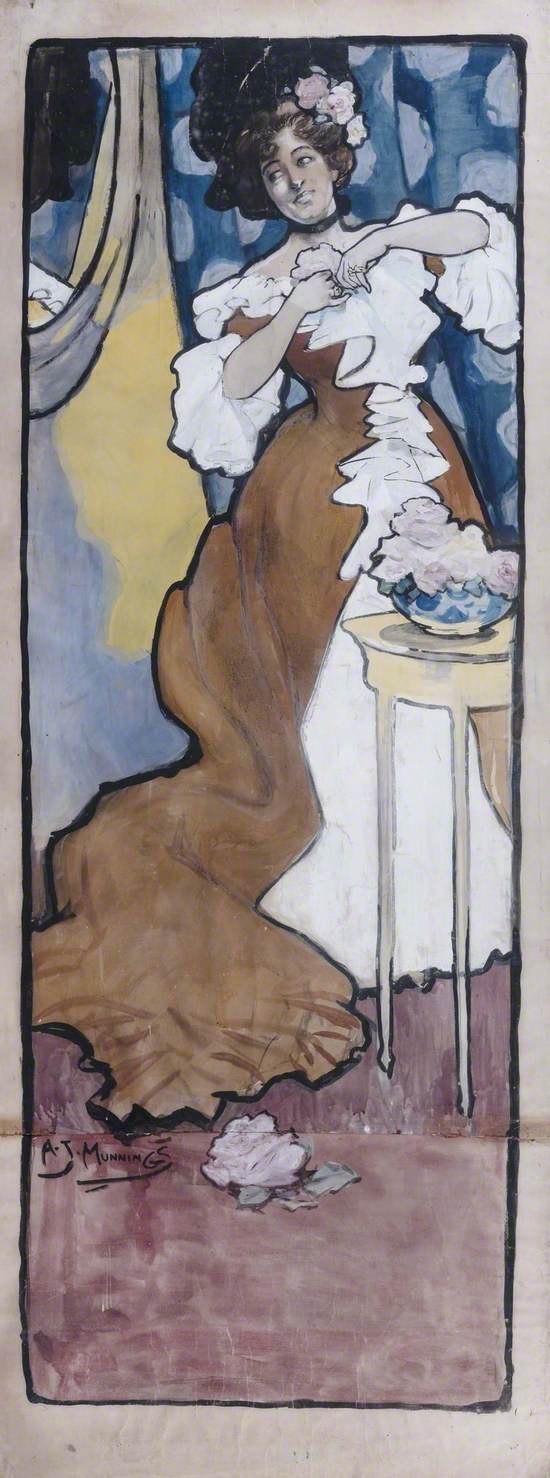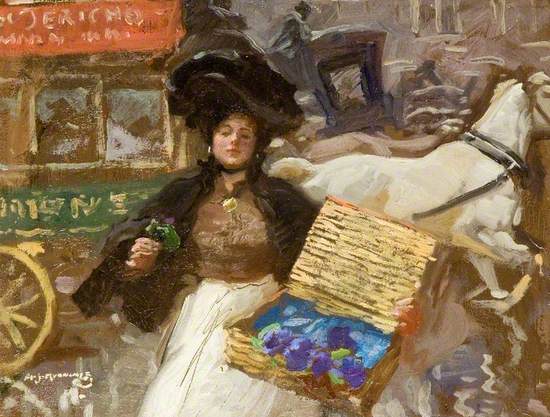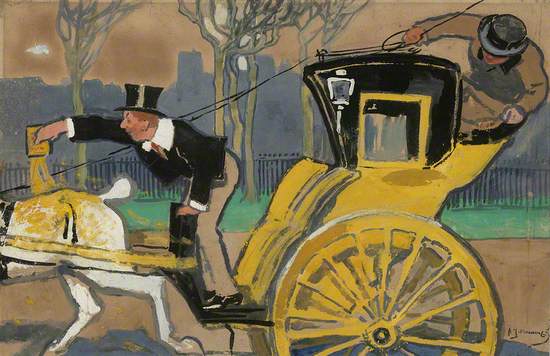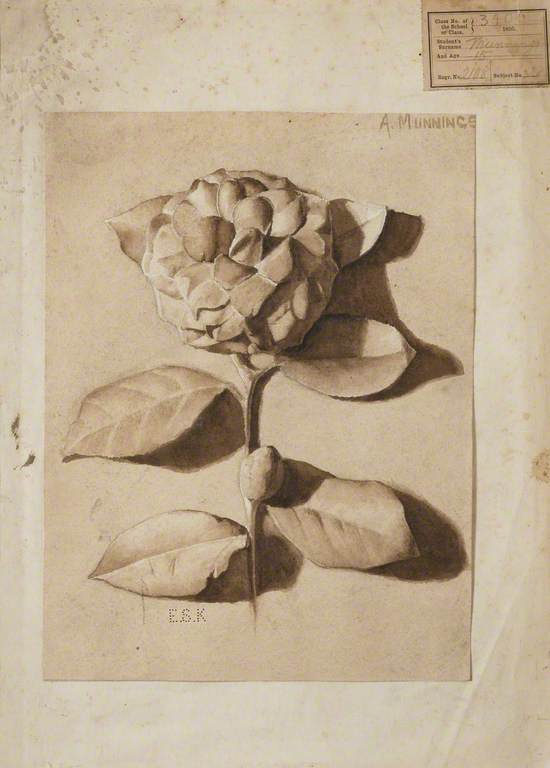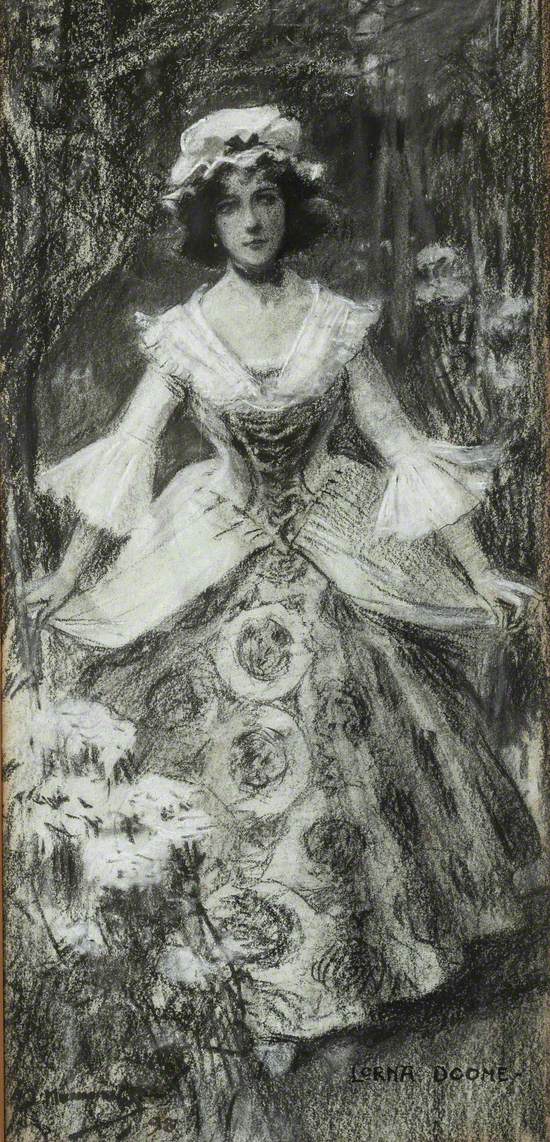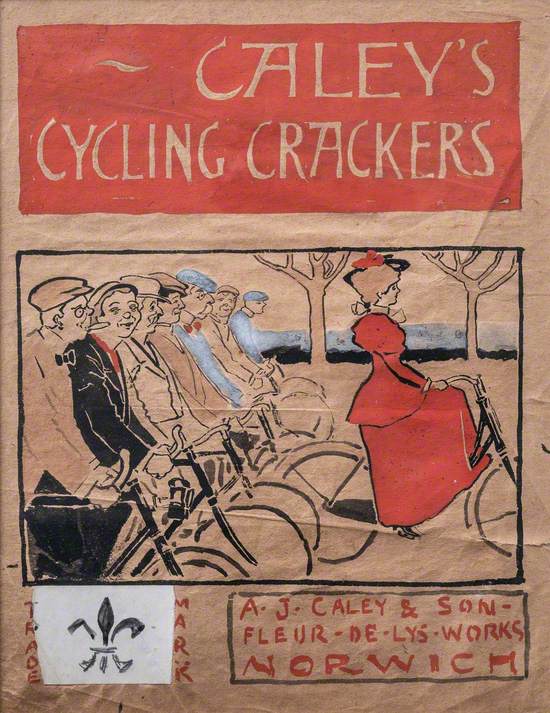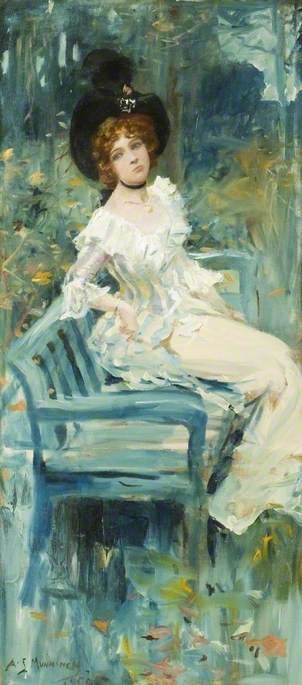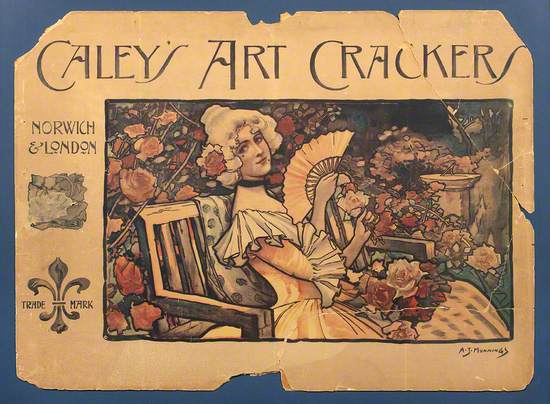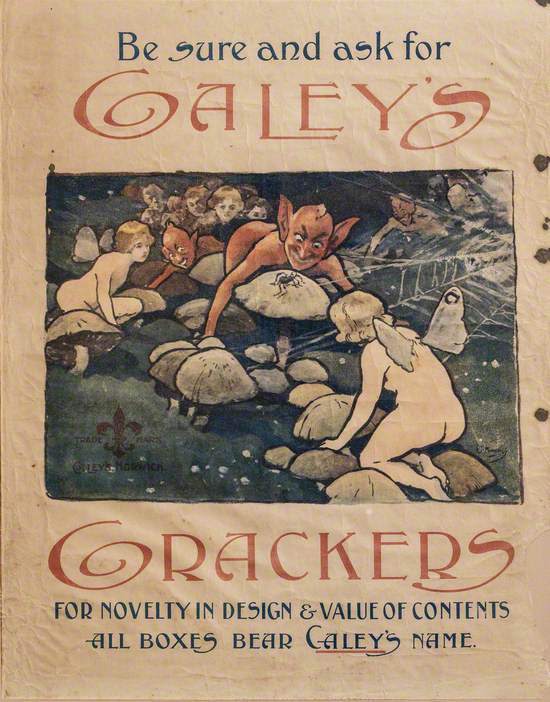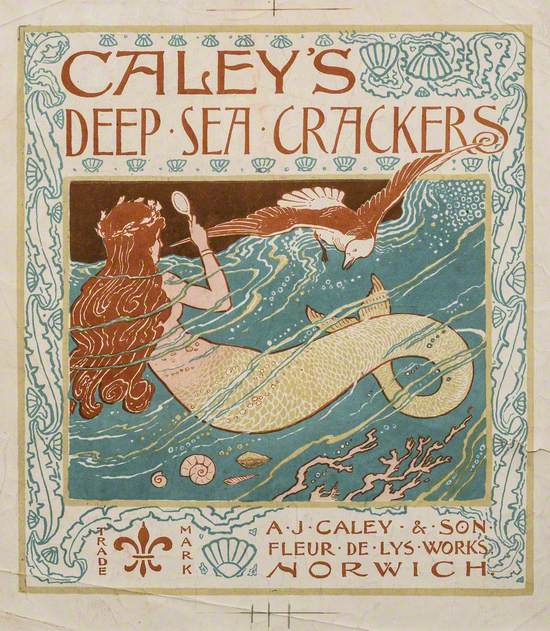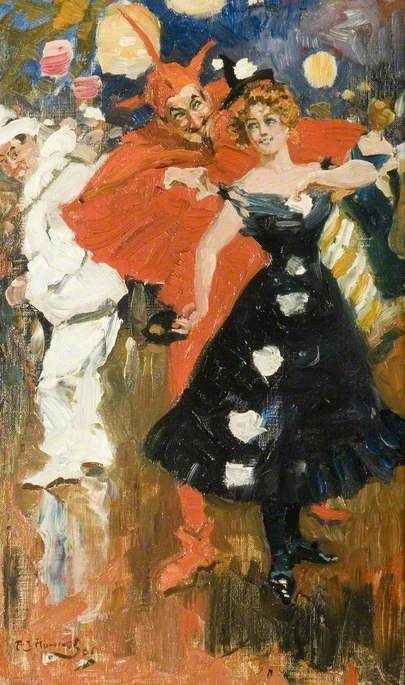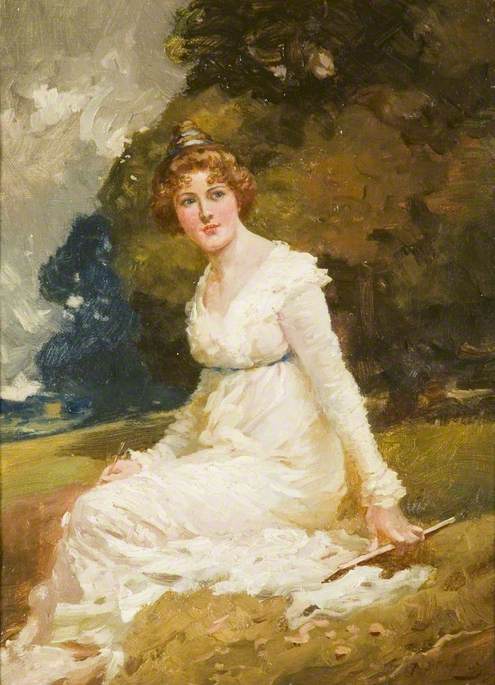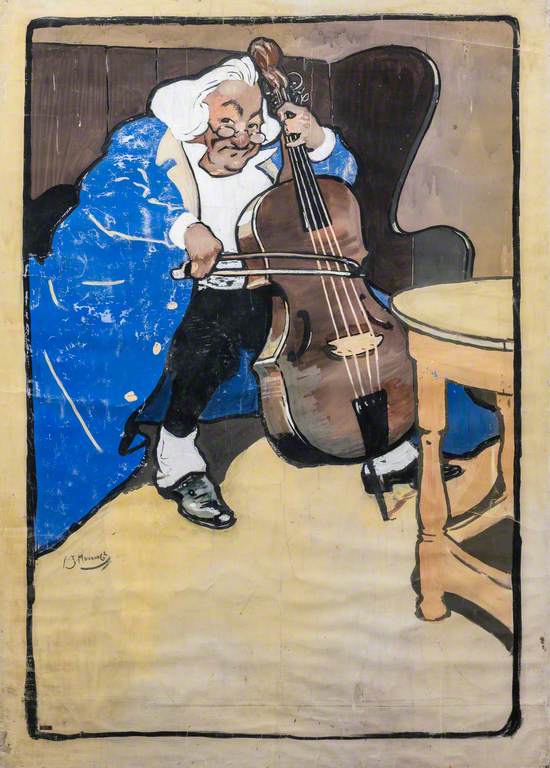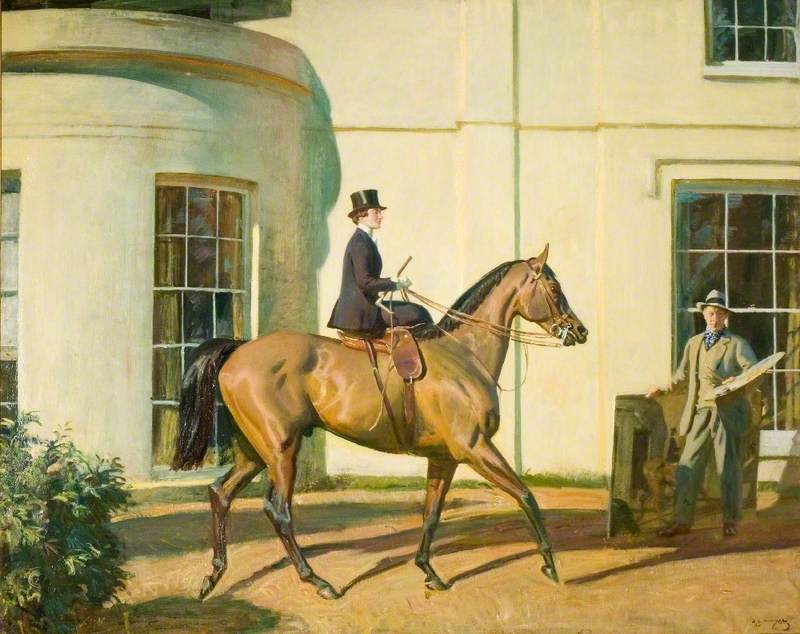In 1892, aged fourteen, Alfred Munnings moved from his home village of Mendham in Suffolk to the city of Norwich. He was apprenticed for six years to the lithographic printers Page Bros. & Co., Ltd. Here he learnt to design advertisements and posters and undertook work for successful local companies such as Colman’s Mustard and Caley’s Crackers.
In 2022 the museum presents a vibrant display of Munnings’ lesser known commercial designs, posters, black and white pictures and early paintings. The exhibition focusses on the early influences on a young Munnings and his ability to capture the popular aesthetic of La Belle Epoque.
Experience highlights from the exhibition in this Art UK Curation.
Lady with a Rose
Painted at Mendham, this original poster design was entered into the Poster Academy at Crystal Palace where it won the silver medal in 1899.
Alfred James Munnings (1878–1959)
Poster colour on paper
H 269.3 x W 99 cm
The Munnings Art Museum
Flower Girl, Violets
Munnings was immersed in a new city environment, inspired by trips to the theatre and the new people that he met. These influences can be seen in both his commercial and personal work.
This composition places the woman in the foreground while the busy Norwich ‘street life’ whirled around behind her.
Alfred James Munnings (1878–1959)
Oil on canvas
H 35.6 x W 45.7 cm
The Munnings Art Museum
Design for an Advert, 'Colman's Mustard'
The people of Norwich also inspired Munnings poster work. This design was never used.
Alfred James Munnings (1878–1959)
Poster colour on paper
H 27.5 x W 43 cm
The Munnings Art Museum
Study of a Plaster Cast, 'Camellia'
This painting, of a plaster cast, shows the level of detail demanded by Munnings tutor, Gertrude Offord, of her students at Norwich School of Art.
This was Munnings’ examination piece.
Later in the first volume of his Autobiography 'An Artists' Life' Munnings writes: “My artistic career began when my eyes were opened to all the never-ending wonders of perspective and light and shade”.
Alfred James Munnings (1878–1959)
Sepia wash on paper
H 38 x W 28 cm
The Munnings Art Museum
Lorna Doone
In 1897 Munnings joined the Norwich Art Circle. It is likely that he was introduced to the circle by Gertrude Offord. He worked hard to create paintings worthy of submission to their twice yearly exhibitions.
“... all my efforts were made with the hope that I might shine there and perhaps sell my work.”
Each May, the Norwich Art Circle held a unique exhibition of black and white works. Munnings was an avid reader, he was very familiar with the classic Victorian novelists and poets. Often his submissions to these black and white exhibitions were imagined scenes depicting heroes and heroines of literature, like this pastel work 'Lorna Doone'.
Munnings was introduced to R.D. Blackmore’s novel Lorna Doone by a colleague at Page Bros.
Alfred James Munnings (1878–1959)
Pastel on paper
H 36 x W 17 cm
The Munnings Art Museum
Design for a Box Top, 'Caley's Cycling Crackers'
Munnings learnt to design posters and advertising during the 1890s, at this time the poster craze was in full bloom.Facilitated by lithography’s ability to mass produce designs, the streets of Paris, Milan and Berlin were turned into public art galleries, ushering in the modern age of advertising.
Lithography uses a simple chemical process on a flatplate of stone or metal to create an image. The positiveimage is drawn onto the surface of the plate with a waterrepellent medium like a wax crayon. A printing ink and water mixture is applied to the plate. The ink sticks to the positive image and the water cleans the rest away.
Alfred James Munnings (1878–1959)
Poster colour on paper
H 25 x W 20 cm
The Munnings Art Museum
Cassie Jeweller
Munnings used the local people that he knew as models for both his paintings and in his poster designs. The women are depicted in contemporary clothes with charming dresses, hats and attractive accessories.
Cassie Jeweller, Catherine Drummond Juler, posed for other Norwich artists as well as Munnings. Cassie is dressed in contemporary fashions dress signified by frilly sleeves, feathered hat and choker necklace.
Alfred James Munnings (1878–1959)
Oil on canvas
H 163 x W 87 cm
The Munnings Art Museum
Design for a Poster, 'Caley's Art Crackers'
Alfred James Munnings (1878–1959)
Lithograph
H 73 x W 100 cm
The Munnings Art Museum
Design for a Poster, 'Caley's Crackers' Design for a Poster, 'Caley's Crackers'
Repeatedly, Munnings used fairy-tale fantasy creatures to inspire his illustrations. Cleverly using this fashionable imagery to make a winning design.
The Victorian era witnessed the growing popularity and publication of fairy and fantastical tales. The fascination with subject was instigated by the publication of Alice’s Adventures in Wonderland by Lewis Carroll in 1865 which continued into the 20th century.
In this poster design for Caley's Crackers, Munnings has used many of the typical fairylike imagery such as wings, pointed ears and toadstools.
Alfred James Munnings (1878–1959)
Lithograph
H 56 x W 44 cm
The Munnings Art Museum
Design for a Box Top, 'Caley's Deep Sea Crackers'
This cracker box top design includes the fantastical character of the mermaid.
Alfred James Munnings (1878–1959)
Lithograph
H 22.5 x W 19.5 cm
The Munnings Art Museum
Pierrette (Reclining Lady)
Munnings’ use of historical costume is key to the character creation in his poster designs. One of his most recognisable motifs is the Pierrot. During the 1880s and 90s the Pierrot figure became popular once again and could be found across all the visual arts.
Alfred James Munnings (1878–1959)
Poster colour on paper
H 133 x W 199 cm
The Munnings Art Museum
The Fancy Dress Ball
Here we get a glimpse of Munnings’ love of drama, costume and story-telling, as well as the strong influence of his adverting designs for Page Bros. It is also an example of Munnings’ exuberant use of colour and uninhibited, impressionistic, brush-work that were a feature of his painting in the early years of the 20th century.
Popular pierot and pierrette costumes were a fancy dress favourite of the 1890s and early 1900s. The costumes were easy to make and fit to a variety of sizes, using cheap and commercially available fabrics.
Alfred James Munnings (1878–1959)
Oil on canvas
H 50.8 x W 30.8 cm
The Munnings Art Museum
A Lady Seated in a Park
Many of Munnings’ poster designs feature characters in Georgian costume. Munnings’ had a great fascination with the Georgian period. He refers to this in his autobiography: “This was the period of costume that I liked best of all.”
Alfred James Munnings (1878–1959)
Oil on canvas
H 40.6 x W 30.5 cm
The Munnings Art Museum
The Solo
Chosen from amongst 240 entries at the Poster Academy at Crystal Palace in London this design, of a man in Georgian costume playing a cello, won the gold medal.
Short of money, he sold the medal for six gold sovereigns and spent the money on a celebratory dinner. He later regretted parting with the prize but was unable to retrieve it.
Alfred James Munnings (1878–1959)
Poster colour on cloth backed paper
H 193 x W 173 cm
The Munnings Art Museum
